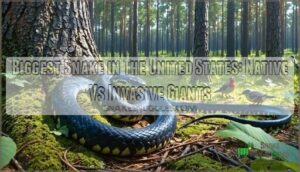This site is supported by our readers. We may earn a commission, at no cost to you, if you purchase through links.

You’ll spot them from Georgia to Florida, where they’re busy keeping ecosystems balanced by munching on rodents and even venomous snakes. While invasive Burmese pythons in the Everglades can dwarf them at over 20 feet, the eastern indigo remains America’s homegrown champion.
These federally protected serpents face serious challenges from habitat loss and competition with non-native species, but their ecological importance can’t be overstated.
Table Of Contents
- Key Takeaways
- Largest Native Snake in The United States
- Notable Invasive Giant Snakes in The U.S
- Comparing Native and Invasive Snake Sizes
- Conservation Status and Threats to Large Snakes
- Florida’s Role as a Snake Hotspot
- Frequently Asked Questions (FAQs)
- What is the largest snake in America?
- What is the largest invasive snake in America?
- What is the largest venomous snake?
- What is the largest rattlesnake?
- How do large snakes affect local ecosystems?
- Are there any natural predators for these snakes?
- What measures are taken to track snake populations?
- How do invasive snakes spread to new areas?
- What are the safety concerns for residents?
- What do large snakes eat in America?
- Conclusion
Key Takeaways
- You’ll discover the eastern indigo snake is America’s largest native species, at up to 9.2 feet, making it a true giant among North American serpents despite being dwarfed by invasive species.
- You’re seeing invasive Burmese pythons dominating Florida’s ecosystems, at over 20 feet long, creating serious ecological disruption by eliminating 90% of mammal populations in the Everglades.
- You’ll find that habitat loss and invasive species competition have pushed the eastern indigo snake to federally threatened status, requiring active conservation efforts to protect this native champion.
- You can expect Florida’s warm climate and diverse wetlands to continue serving as America’s snake hotspot, where both native giants and invasive species compete for survival in complex ecosystems.
Largest Native Snake in The United States
When you’re searching for America’s largest native snake, you’ll find the eastern indigo snake (Drymarchon couperi) holding that impressive title.
This federally protected species can stretch up to 9.2 feet long, making it a true giant among North America’s indigenous serpents.
Eastern Indigo Snake Overview
While most Large Snake Species roam other continents, the Eastern Indigo Snake (Drymarchon couperi) stands as America’s longest native serpent.
You’ll find this dominant predator playing a key Ecosystem Role, using its impressive Indigo Diet to hunt everything from venomous snakes to mammals.
Unfortunately, Non Native Snakes now compete in their territory, making Snake Conservation critical for protecting these glossy, iridescent "lords of the forest" who’ve survived alongside the Eastern Diamondback Rattlesnake for centuries through careful Snake Migration patterns and Snake Behavior adaptations.
Physical Characteristics and Size
You’ll recognize an eastern indigo snake by its impressive snake length of up to 9.2 feet, though most adults measure 5-7 feet. Their body mass reaches a maximum of 11 pounds.
Unlike reticulated python or Burmese python morphology, indigos display glossy blue-black scale patterns that shimmer in sunlight.
Growth rates vary substantially—males usually outsize females among large snake species. This non-native snake comparison shows eastern indigos remain smaller than green anaconda specimens.
Range and Preferred Habitats
Eastern Indigo Snakes inhabit southeastern pine forests, scrublands, and freshwater marshes from Georgia to Florida. You’ll find them in Habitat Diversity ranging from dry uplands to wetlands. Their Geographic Range once extended further north, but Habitat Loss reduced populations.
These snakes show impressive Climate Adaptation, maintaining Ecosystem Balance through rodent control. Unlike invasive Reticulated Pythons, indigos need specific native habitats for survival and successful reproduction.
To create suitable environments, understanding proper ventilation systems is necessary for maintaining prime health.
Notable Invasive Giant Snakes in The U.S
You’ll encounter several invasive python species that have established populations in U.S. ecosystems, particularly in Florida’s warm climate. These non-native giants, including Burmese pythons (Python bivittatus) and occasional reticulated python (Malayopython reticulatus) sightings, now compete with native species for resources and habitat.
Burmese Python Presence in Florida
You’ll find the Burmese Python invasion represents Florida’s most challenging Wildlife Management crisis. These Invasive Species escaped the Exotic Pet Trade, transforming the Everglades Ecosystem into their hunting ground.
- Burmese Python populations occupy over 1,000 square miles of southern Florida
- Conservative estimates suggest tens of thousands inhabit Everglades National Park
- Python Habitat includes wetlands, mangroves, and even suburban developments
- Snake Control efforts have removed over 21,000 pythons since the mid-2000s
- Habitat Loss for native species accelerates as pythons dominate food webs
The invasive species issue is further complicated by the everglades ecosystem dynamics that favor the python’s survival.
Reticulated Python and Green Anaconda Sightings
You might spot Reticulated Python and Green Anaconda individuals across Florida, though they’re less common than Burmese pythons. These encounters usually involve escaped or released pets from the Exotic Pet Trade.
Reticulated Python specimens can exceed 20 feet, while Green Anaconda sightings remain rare but concerning. Wildlife Invasion Management teams monitor these Invasive Species closely, as both Nonvenomous Snake species threaten native wildlife through Habitat Loss and predation pressures.
Impact on Local Ecosystems
Ecosystem disruption becomes inevitable when invasive species like Burmese pythons dominate Florida’s landscapes. You’ll witness dramatic biodiversity loss as these nonvenomous snakes consume native species faster than ecosystems can adapt.
Wildlife dynamics shift dramatically – top predators eliminate mammals, birds, and reptiles that maintained ecological roles for millennia. Habitat loss compounds these invasive impacts, creating cascading effects throughout interconnected ecosystems.
Comparing Native and Invasive Snake Sizes
When you compare native and invasive snake species, you’ll find dramatic size differences that reshape America’s reptilian landscape.
The eastern indigo snake reaches 9 feet as our largest native species, while invasive Burmese pythons can exceed 16 feet in Florida’s wild populations.
Eastern Indigo Snake Vs. Burmese Python
When comparing these two titans, you’ll notice striking differences in Snake Behavior and ecological impact. The Eastern Indigo Snake, our largest Native Snake Species, reaches 9 feet maximum, while Burmese Python invaders dwarf them at 16+ feet in Snake Habitat like the Everglades.
This size difference disrupts Predator Prey relationships and Ecological Balance. Both are Nonvenomous Snake species, but the Invasive Species threatens native populations through competition and direct predation.
Heaviest and Longest Records
Record-breaking snakes dominate size charts in America. The heaviest Burmese Python reached 215 pounds in Florida, while Green Anaconda sightings suggest even larger specimens exist. For snake length records, invasive pythons consistently outmeasure natives. The Eastern Diamondback Rattlesnake remains our longest venomous native at eight feet, but giant snake sightings of 19-foot Burmese pythons dwarf all heavy species comparisons.
The capture of large snakes is often facilitated by python control efforts.
Factors Influencing Maximum Size
Snake genetics play the biggest role in determining maximum size potential. You’ll find that Burmese Python and Green Anaconda specimens reach impressive lengths when habitat quality provides abundant food availability.
Climate factors affect growth patterns substantially – warmer temperatures boost metabolism in these cold-blooded giants.
Eastern Indigo Snake populations show smaller maximum sizes compared to invasive species like Boa Constrictor and African Rock Python due to evolutionary adaptations.
Conservation Status and Threats to Large Snakes
You’ll find that America’s largest snakes face serious conservation challenges, from habitat destruction to invasive species competition.
The eastern indigo snake’s threatened status under the Endangered Species Act highlights how human activities and non-native pythons threaten our native giants.
Endangered Status of The Eastern Indigo Snake
Since 1978, you’ll find the Eastern Indigo Snake protected under the Endangered Species Act as a threatened species . This Wildlife Protection designation means population declines triggered federal intervention for Snake Conservation.
Habitat loss led to this federally threatened species status in Georgia and Florida, making Habitat Preservation essential for Ecological Balance and endangered species recovery efforts.
Understanding snake species information is essential for effective conservation and management of snake populations.
Habitat Loss and Fragmentation
Habitat destruction threatens your understanding of large snake conservation in America. Urban development and agriculture eliminate critical ecosystems where native species like the eastern indigo snake once thrived.
- Habitat Destruction: Agriculture converts 97% of longleaf pine forests into farmland
- Fragmentation Effects: Roads create deadly barriers between snake populations
- Wildlife Corridors: Connected habitats allow genetic diversity and movement patterns
- Ecosystem Disruption: Development breaks natural food webs supporting large snakes
- Conservation Strategies: Habitat restoration programs reconnect fragmented landscapes through targeted preservation efforts
Effects of Invasive Species
You’ll witness devastating ecological disruption when invasive species like the Burmese python establish populations. These giants outcompete native species for food sources, leading to biodiversity loss across affected habitats.
Native species decline rapidly as nonvenomous snakes face unforeseen competition. Habitat invasion by these predators fundamentally alters ecosystem balance, creating cascading effects throughout food webs.
Florida’s Role as a Snake Hotspot
You’ll find Florida stands as the nation’s snake capital, where warm temperatures and diverse ecosystems create perfect conditions for both native species like the eastern indigo snake and invasive giants such as Burmese pythons.
The Everglades’ vast wetlands have become ground zero for some of the largest snake populations in North America, making wildlife management efforts more critical than ever.
Everglades as Prime Habitat
You’ll find the Everglades Ecosystem offers unique Habitat Diversity for large serpents. These freshwater marshes create perfect conditions for Snake Migration patterns.
The Eastern Diamondback Rattlesnake thrives alongside invasive species here. Unfortunately, the Burmese Python exploits these rich habitats too.
Each nonvenomous snake competes for resources in this complex wetland system that desperately needs Wetland Conservation efforts. Understanding snake habitat ecosystems is essential for effective conservation.
Wildlife Management and Control Efforts
Florida’s wildlife managers aren’t just sitting around watching pythons take over. You’ll find coordinated removal programs pulling thousands of invasive species from the Everglades yearly, supporting ecosystem balance through active snake monitoring and habitat restoration efforts.
- Over 23,500 Burmese pythons removed since 2017 through targeted conservation efforts
- Python Challenge events mobilize nearly 1,000 participants to protect endangered species
- No-cost training programs teach you to identify and safely remove invasive constrictors
- Military veterans hired as professional python hunters under the Endangered Species Act
Frequently Asked Questions (FAQs)
What is the largest snake in America?
You’re probably expecting some massive monster, but the eastern indigo snake (Drymarchon couperi) claims the title as America’s longest native serpent, stretching up to 2 feet when fully grown.
What is the largest invasive snake in America?
You’ll encounter the Burmese python as America’s largest invasive snake species. These Southeast Asian giants regularly reach sixteen feet in Florida’s Everglades, where they’ve established thriving populations after escaping captivity.
What is the largest venomous snake?
You’ll encounter the eastern diamondback rattlesnake (Crotalus adamanteus), North America’s longest and heaviest venomous snake.
Adults usually reach 3-6 feet, but some specimens grow to 8 feet and weigh up to 10 pounds. These impressive pit vipers rule southeastern forests.
What is the largest rattlesnake?
You’ll encounter the eastern diamondback rattlesnake (Crotalus adamanteus) as North America’s largest rattler. These impressive serpents reach eight feet long and weigh over ten pounds, making them true giants among venomous species.
How do large snakes affect local ecosystems?
Invasive Burmese pythons have eliminated 90% of mammal populations in the Everglades .
You’ll see dominant predators disrupting food webs, competing with native species like eastern indigo snakes, and triggering cascading ecological effects that permanently alter biodiversity patterns.
Are there any natural predators for these snakes?
You’ll find that alligators, hawks, eagles, kingsnakes, and other large snakes naturally prey on them. However, adult Burmese pythons and eastern indigo snakes face few predators due to their size.
What measures are taken to track snake populations?
Scientists track snake populations through radio telemetry, GPS tracking, mark-recapture studies, visual encounter surveys, and citizen science apps. You’ll find researchers using pit tags and genetic sampling for identification.
How do invasive snakes spread to new areas?
Pet-driven pathways pose particular problems for preventing python proliferation. You’ll find invasive snakes spread through pet trade releases, cargo transportation, and accidental escapes, with human activity serving as the primary vector.
What are the safety concerns for residents?
You’ll face minimal danger from large snakes. Human fatalities from non-venomous snakes are very rare, probably averaging one or two per year worldwide, and there have been no human deaths from wild-living Burmese pythons in Florida.
Keep proper distance and stay alert outdoors.
What do large snakes eat in America?
America’s heavyweight serpents absolutely devour everything from mice to deer! You’ll find Burmese pythons tackling alligators, while native rattlesnakes prefer rabbits, birds, and rodents for their protein-packed meals.
Conclusion
Like a chess match between native and invasive giants, understanding what’s the biggest snake in the United States reveals a complex ecological battle. You’ve discovered that while the eastern indigo snake (Drymarchon couperi) reigns as America’s largest native serpent at 9.2 feet, invasive Burmese pythons dwarf them at over 20 feet.
You’ll find these invasive species threatening Florida’s delicate ecosystems, making conservation efforts for our native giants more critical than ever.
- https://a-z-animals.com/blog/discover-the-largest-eastern-indigo-snake-ever-recorded/
- https://ecos.fws.gov/ecp/species/646
- https://www.aol.com/largest-snake-species-north-america-163200884.html
- https://en.wikipedia.org/wiki/Eastern_diamondback_rattlesnake
- https://myfwc.com/wildlifehabitats/profiles/reptiles/snakes/eastern-diamondback/














